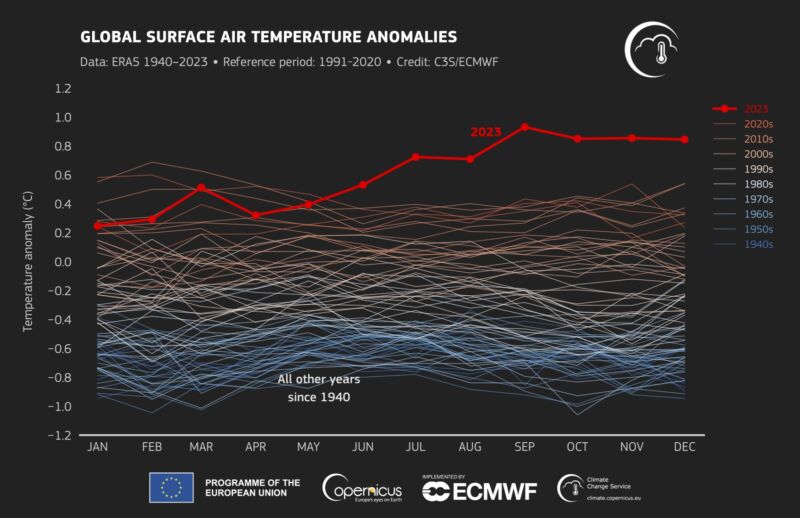
The confused wiggles on the graph above have a simple message: Most years, even years with record-high temperatures, have some months that aren't especially unusual. Month to month, temperatures dip and rise, with the record years mostly being a matter of having fewer, shallower dips.
As the graph shows, last year was not at all like that. The first few months of the year were unusually warm. And then, starting in June, temperatures rose to record heights and simply stayed there. Every month after June set a new record for high temperatures for that month. So it's not surprising that 2023 will enter the record books as far and away the warmest year on record.
The EU makes it official
Several different organizations maintain global temperature records; while they use slightly different methods, they tend to produce very similar numbers. So, over the next few weeks, you can expect each of these organizations to announce record temperatures (NASA and the National Oceanic and Atmospheric Administration will do so on Friday). On Tuesday, it was the European Union's turn, via its Copernicus Earth-observation program.
Copernicus rates 2023 as being nearly 1.5° C above pre-industrial temperatures and about 0.17° C above 2016, the previous holder of the warmest year on record. The difference between 2023 and 2022 was the largest single-year change in the record as well, confirming that the amount of warming this past year was exceptional.
The 1.5° C landmark is significant because many countries have committed to trying to limit global warming to that mark. This doesn't mean we've failed; the average temperature for the last decade is still below that. But it does highlight how little time we have left to act before we potentially experience more radical consequences of climate change.
The Copernicus analysis notes a couple of additional daily landmarks within the yearly record. It defines pre-industrial temperatures as those experienced between 1850–1900. The records from this period are sparse enough that, rather than daily temperature data, it's been handled as a monthly average. So, the best Copernicus could do is compare 2023's daily temperatures to the equivalent month in the pre-industrial record.
Even given that limitation, some of the results of this comparison were striking. For the first time ever, individual days in 2023 were 2.0° C above the preindustrial monthly average. Nearly half the days in 2023 were 1.5° C warmer than preindustrial records, and it was the first time every day was at least 1.0° C warmer.
Why so extreme?
The simplest answer is El Niño. The past few years have been spent in a reasonably strong La Niña, the cooler phase of the Southern Oscillation. But that started fading throughout the spring, and by mid-year, a weak El Niño had arrived. Normally, a relatively feeble El Niño like this would have a limited effect on global temperatures, and in any case, it would normally take some time for its effect to be felt in global temperatures.

But with temperatures poised near record levels to begin with, just a little push appeared to be all 2023 needed to soar to record heights.
Still, there are plenty of indications that the year wasn't only the result of El Niño, which is a phenomenon that occurs in the tropical Pacific. For example, the North Atlantic, which is not directly connected to the Tropical Pacific, experienced exceptionally warm sea surface temperatures over the second half of the year.
Copernicus suggests that several additional, weak factors could have contributed to the year's warmth. These include lower emissions of cooling aerosols from shipping, a peak in the solar cycle, and high levels of water vapor in the stratosphere due to the eruption of the Hunga Tonga volcano. On its own, the impact of any of these would likely be minimal. In combination with the weak El Niño and the continued emission of greenhouse gasses, however, they might have enhanced what was already an exceptionally warm year.
The announcement of 2023's warmth comes only months after a set of UN climate negotiations that many have derided as lacking the sort of urgency the record might have provided. Instead, Copernicus notes that carbon dioxide and methane emissions increased last year.
Listing image by Marco Bottigelli


3175x175(CURRENT).thumb.jpg.b05acc060982b36f5891ba728e6d953c.jpg)

Recommended Comments
There are no comments to display.
Join the conversation
You can post now and register later. If you have an account, sign in now to post with your account.
Note: Your post will require moderator approval before it will be visible.